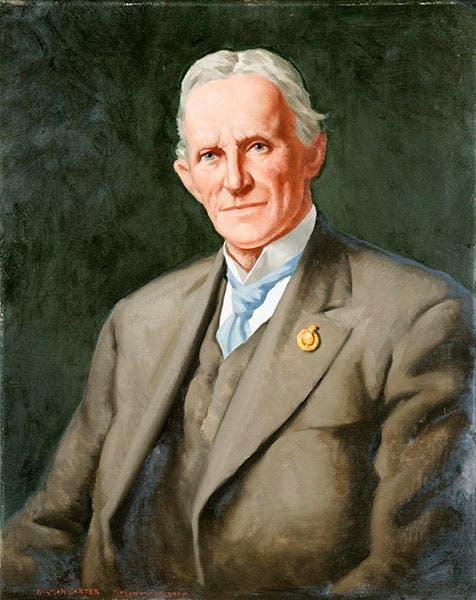Scientist of the Day - Edgeworth David
Edgeworth David, a Welsh/Australian geologist, was born Jan. 28, 1858. David moved to Australia and was teaching geology at the University of Sydney in 1906 when Ernest Shackleton came through, recruiting scientists for his proposed British Antarctic Expedition, commonly called the Nimrod Expedition, after the name of the ship involved. David volunteered, and Shackleton was happy to have him, since David had an excellent reputation as a geologist. David originally intended to come back after the first summer season, but as it turned out, he stayed with the expedition all three years, 1907-1909. Moreover, he was directly involved with the two unqualified successes of the Nimrod expedition. He led a party that, in 1908, first climbed to the crater rim atop Mt. Erebus, an active Antarctic volcano near the Ross Sea. We show here a modern photo of the volcano (second image),
as well as a photo that was taken in 1908 that captured the successful ascent (third image).
David also led a party of three on the first successful expedition to reach the South Magnetic Pole, which they attained on Jan. 16, 1909. The North Magnetic Pole had been visited in 1831, but that was comparatively easy, once one got a ship into the Arctic archipelago. The South Magnetic Pole, however, was in a God-forsaken part of Antarctica, and it required a sledge journey of some three months to get there. The other two men involved were Alistair Mackay and Douglas Mawson, both of whom had also made the ascent of Mt. Erebus with David. A photo (taken by a mysterious fourth man?) shows the three posing at the Pole (first image; David is in the center, Mawson at right). Mawson was also an Australian, and this achievement made David and Mawson national heroes in the Land Down Under. Shackleton did not acquire equal distinction on the Nimrod Expedition, for he was unable to reach the geographic South Pole. But he would make up for that seven years later, when he sailed the James Caird 900 miles from Elephant Island to South Georgia in the most unbelievable small-boat voyage ever, saving the entire crew of the Endurance.
Climbing Mt. Erebus was apparently not postage stamp material, but standing at the South Magnetic Pole was, as a variety of stamps, issued in 1959 and 2009, reproduce the famous Antarctic photo. We show the first issue, an Australian stamp minted for their Antarctic Territory (fourth image).
Since the South Magnetic Pole is constantly on the move (see map, fifth image), it is much easier to reach these days, since you can sail a ship right up to it.
There is an oil portrait of David in the National Museum of Wales (sixth image)
Dr. William B. Ashworth, Jr., Consultant for the History of Science, Linda Hall Library and Associate Professor, Department of History, University of Missouri-Kansas City. Comments or corrections are welcome; please direct to ashworthw@umkc.edu.











